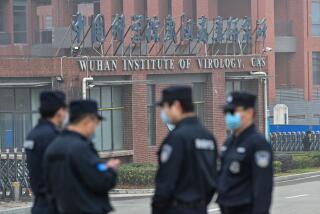Mystery Illness Could Be Related to Virus That Causes the Common Cold, CDC Says
- Share via
As a mysterious pneumonia-like illness continued to spread around the globe, U.S. researchers said Monday that they believe it is caused by a virus related to those that produce the common cold.
Dr. Julie Gerberding, director of the federal Centers for Disease Control and Prevention, said virologists there had been unable to find traces of the paramyxovirus that was an initial suspect in the disease, called severe acute respiratory syndrome, or SARS. Now, they believe they have “very strong evidence” that a new member of the coronavirus family is the culprit.
Using diagnostic tests obtained from the CDC, several other labs around the world have also found indications of the new virus in patients.
CDC scientists think this new strain of coronavirus is a likely candidate after isolating it from tissues from lungs and kidneys -- the organs that are most severely damaged by SARS. The researchers have also found that patients they have tested have no antibodies to the virus in the disease’s early stages but develop them later. That is strong evidence that the coronavirus is playing a major role in the infection.
“This is our leading hypothesis based on careful science by some of the world’s best scientists,” Gerberding said.
Department of Defense laboratories have agreed to develop diagnostic reagents for the virus “very rapidly,” she said. The laboratories will also test a variety of antiviral drugs to see whether any are effective in slowing or halting infections
The World Health Organization said Monday that there are now 419 cases of SARS in 13 countries, as well as 39 suspected cases in 18 U.S. states. So far, 17 people in Hong Kong, Vietnam and Canada have died of the disease. The totals do not include 300 more suspected cases and five deaths reported earlier in China.
In the early stages of the disease’s spread, most cases were among health-care workers exposed to the victims. As hospitals have increased infection control measures, however, most new cases are among family members and others in close contact with victims.
The most severely affected region is Hong Kong, which as of Monday had reported 260 cases and 10 deaths. On Sunday, Hong Kong’s health chief, Dr. William Ho, was hospitalized with symptoms of the disease -- a surprising development to many experts because he had not been treating patients.
Hong Kong’s health secretary, Dr. Yeoh Eng-kiong, called it “a really very alarming disease.” Government officials have been drawing up health guidelines for restaurants, buses and other public facilities. Singapore has had 65 cases so far, including 14 new cases reported Monday, but no reported deaths. Twelve patients are now in intensive-care units in very serious condition, said Health Minister Lim Hng Kiang. On Monday, Lim ordered about 740 Singapore residents who may have been exposed to victims of SARS to remain in their homes for 10 days, in an effort to halt the spread of the disease. Quarantined people could be fined if caught outside their homes.
Vietnam has had 58 cases and four deaths. Over the weekend, U.S. authorities warned Americans not to travel there because of the risk and poor medical conditions.
Canada has had 11 cases and three deaths.
Gerberding said 32 of the 39 suspected cases in the U.S. were people who had traveled to Asia. The others were health-care workers or family members of victims.
“Fortunately, we are not seeing spread in the community,” she added.
CDC workers are meeting about 65 flights arriving into the U.S. each day and distributing travel alerts reminding passengers to contact a physician if they develop symptoms within 10 days of their return. So far, they have distributed more than 62,000 such alerts. As of Friday, five people had been hospitalized after falling ill on flights to the United States, Gerberding said, but there have been no new instances since then.
CDC officials also met a cargo ship whose crew had reported the illness, but the workers had recovered by the time the ship docked on the West Coast.
Coronaviruses were first isolated from chickens in 1937. By the late 1960s, researchers had concluded that they are responsible for about half of all common colds. In addition to causing colds in humans, the viruses can cause health problems in cattle, pigs, rodents, cats, dogs and birds.
There is no specific treatment for the viruses, which take their name from the crown-like protrusions on their surfaces.
There are three known families of coronaviruses. Limited genetic analysis suggests that the newly discovered one belongs to a fourth family, Gerberding said.
Coronaviruses are normally quite infectious, but the vast majority of SARS cases so far have been the result of prolonged, direct exposure to victims. Researchers believe the virus is transmitted in droplets expelled during coughing.
Gerberding cautioned that the new virus could be simply an innocent bystander in the disease or a co-factor in the infections, “but that is growing less and less likely.”






